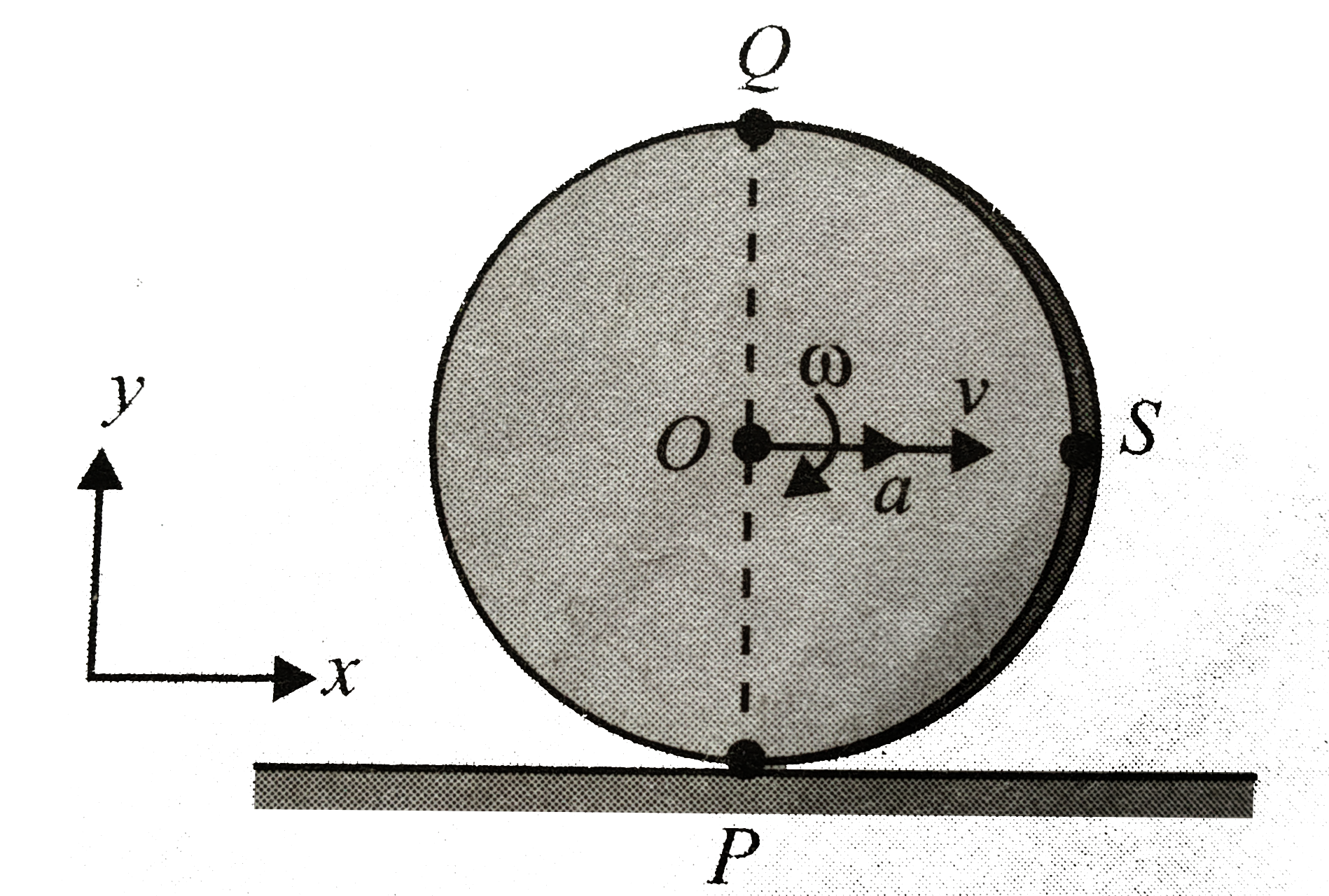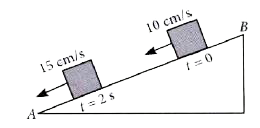A ball of radius R=10.0cm rolls without slipping down an inclined plane so that its centre moves with constant acceleration
w=2.50cm/s2, t=2.00s after the beginning of motion its position corresponds to that shown in figure. Find:
(a) the velocities of the points A, B, and O,
(b) the accelerations of these points.

Let us fix the co-ordinate axis xyz as shown in the figure. As the ball rolls without slipping along the rigid surface so, on the basis of the solution of problem 1.52:
Thus →v0=→vc+→ω×→roc=0vc=ωRand→ω↑⏐
⏐⏐↑⏐
⏐⏐(−→k)as→vc↑⏐⏐↑⏐⏐→i} (1)
and →ωc+→β×→roc=0wc=βRand→β↑⏐
⏐⏐↑⏐
⏐⏐(−→k)as→wc↑⏐⏐↑⏐⏐→i⎫⎬⎭
At the position corresponding to that of figure., in accordance with the problem,
wc=w, so vc=wt
and ω=vcR=wtR and β=wR (using 1)
(a) Let us fix the co-ordinate system with the frame attached with the rigid surface as shown in the figure.

As point O is the instantaneous centre of rotation of the ball at the moment shown in figure.
so, →v0=0,
Now, →vA=→vC+→ω×→rAC
=vC→i+ω(−→k)×R(→j)=(vC+ωR)→i
So, →vA=2vC→i=2wt→i (using 1)
Similary →vB=→vC+→ω×→rBC=→vC→i+ω(−→k)×R(→i)
=vC→i+ωR(−→j)=vC→i+vC(−→j)
So, vB=√2vc=√2wt and →vB is at an angle 45∘ from both →i and →j (figure)

(b) →w0=→wC+ω2(−→roc)+→β×→rOC
=ω2(−→rOC)=v2CR(−ˆuOC) (using 1)
where ˆuOC is the unit vector along →rOC
so, w0=v20R=w2t2R (using 2) and →w0 is directed towards the centre of the ball
Now →wA=→wC+ω2(−→rAC)+→β×→rAC
=w→i+ω2R(−→j)+β(−→k)×R→j
=(w+βR)→i+v2cR(−→j) (using 1) =2w→i+w2t2R(−→j)
So, wA=√4w2+w4t4R2=2w√1+(wt22R)2
Similarly →wB=→wc+ω2(−→rBC)+→β×→rBC
=w→i+ω2R(−→i)+β(−→k)×R(→i)
=(v−v2CR)→i+βR(−→j) (using 1)
=(w−w2t2R)→i+w(−→j) (using 2)
So, wB=√(w−w2t2R)2+w2
Topper's Solved these Questions
- BOOK - IE IRODOV, LA SENA & SS KROTOVCHAPTER - PHYSICAL FUNDAMENTALS OF MECHANICSEXERCISE - The Fundamental Equation Of Dynamics59videos
PHYSICAL FUNDAMENTALS OF MECHANICS
- BOOK - IE IRODOV, LA SENA & SS KROTOVCHAPTER - PHYSICAL FUNDAMENTALS OF MECHANICSEXERCISE - Laws Of Conservation Of Energy, Momentum And Angular Momentum82videos
PHYSICAL FUNDAMENTALS OF MECHANICS
- BOOK - IE IRODOV, LA SENA & SS KROTOVCHAPTER - OSCILLATIONS AND WAVESEXERCISE - Electromagnetic Waves, Radiation36videos
OSCILLATIONS AND WAVES
- BOOK - IE IRODOV, LA SENA & SS KROTOVCHAPTER - THERMODYNAMICS AND MOLECULAR PHYSICSEXERCISE - Transport Phenomena38videos
THERMODYNAMICS AND MOLECULAR PHYSICS
Similar Questions
A uniform sphere of mass 200 g rols withiout slipping on a plane surface so that its centre mioves at a speed of 2.00 cm/s. Find its kinetic energy.
View SolutionConsider a wheel rolls without slipping and its centre moves with constant acceleration a. Find the acceleration of points O,P,Q and S when linear velocity of the centre of wheel is v.
 View Solution
View Solution
Knowledge Check
- Question 1 - Select One
A wheel of radius R=0.1m is rolling without slipping on a horizontal surface as shown in the firgure. Centre of the wheel moves with a constant speed √3m/s. The speed of the point P with respect to ground is
 A2√3m/sBzeroC3 m/sD√3m/s
A2√3m/sBzeroC3 m/sD√3m/s - Question 2 - Select One
A uniform hollow sphere of mass 200 g rolls without slipping on a plane horizontal surface with its centre moving at a speed of 5.00 cm/s. Its kinetic energy is:
A4.17×10−4JB8.72×10−3JC6.25×10−4JD3.61×10−4J - Question 3 - Select One
A uniform hollow sphere of mass 400 g rolls without slipping on a plane horizontal surface with its centre moving at a speed of 10 cm/s. Its kinetic energy is:
A4×10−3JB8×10−3JC3.33×10−3JD3.5×10−3J
A trolley, while going down an inclined plane, has an acceleration of 2cm/s2 starting from rest. What will be its velocity 3s after the start ?
View SolutionA particle moves with deceleration along a circle of radius R so that at any moment its tangential and normal accelerations are equal in moduli. At the initial moment t=0 the velocity of the point equals v0. Find (a) the velocity of the point as a function of t and s , (b) the resultant acceleration modulus as a function of v.
View Solution(a) A rigid body of radius of gyration k and radius R rolls without slipping down a plane inclined at an angle θ with the horizontal. Calculate its acceleration and the frictional force acting on it.
(b) If the body be in the form of a disc and θ=30∘, what will be the acceleration and the frictional force acting on it.View SolutionAt t = 0, block B in figure starts moving with a velocity 15 cm/s and with a constant acceleration. It is observed that after blocks travels 24 cm to the right its velocity is 6cm/s. Find:
(a) The accelerations of A and B,
(b) The acceleration of point M of the string.View SolutionAn object is sliding down an inclined plane. The velocity changes at a constant rate from 10 cm/s to 15 cm/s in two seconds. What is its acceleration ?
 View Solution
View Solution

